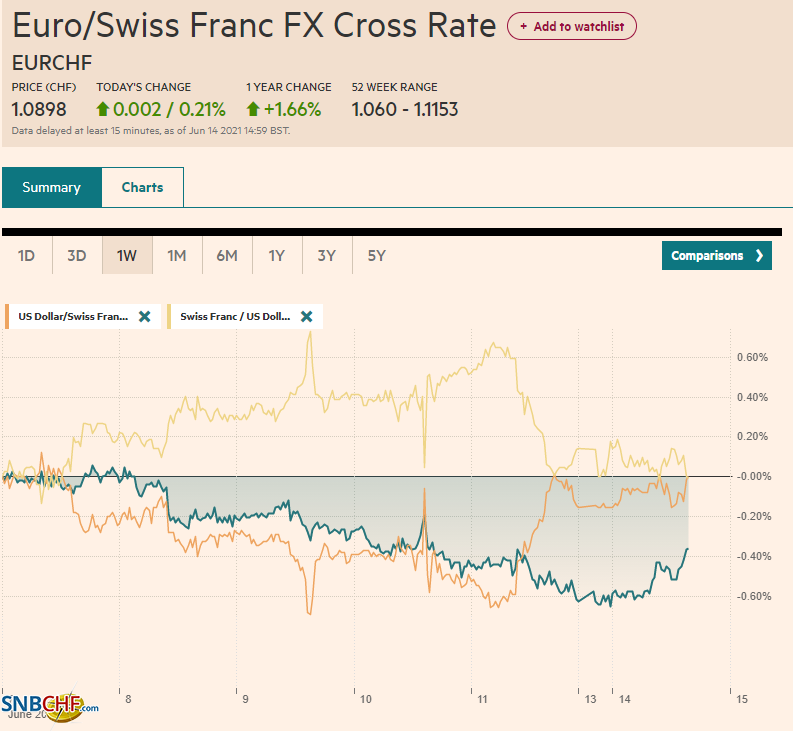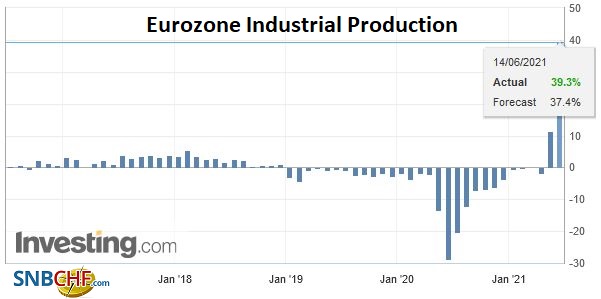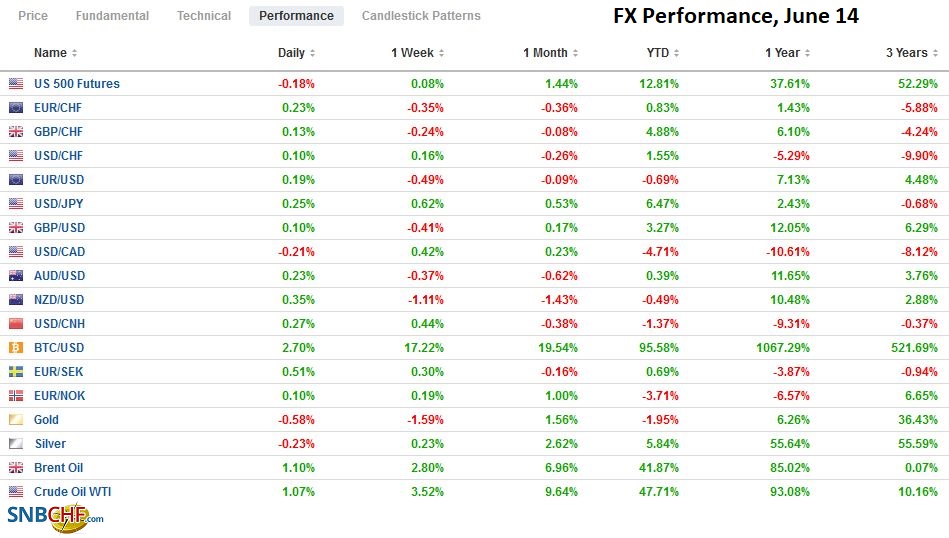Swiss FrancThe Euro has risen by 0.21% to 1.0898 |
EUR/CHF and USD/CHF, June 14(see more posts on EUR/CHF, USD/CHF, ) Source: markets.ft.com - Click to enlarge |
FX RatesOverview: The short squeeze that lifted the US dollar ahead of the weekend has seen limited follow-through buying, and instead a consolidative tone emerged. Europe is searching for direction and perhaps waiting for US leadership after a quiet Asia Pacific session, with several centers closed for holiday today (China, Hong Kong, Taiwan, and Australia). Japanese and South Korean equities advanced. Europe’s Dow Jones Stoxx 600 is up for the seventh consecutive session. Gains in information technology, energy, and utilities are helping to lift the benchmark to new record highs. US equity futures are posting minor gains. Benchmark 10-year yields are slightly firmer. The US yield is at 1.46% after shedding 10 bp last week, the most since last June. Outside of the Norwegian krone (~+0.25%) and sterling (~-0,20%), the major currencies are +/- less than 0.1%. Emerging market currencies are also mostly quiet. The Turkish lira is extending its recovery. It is the seventh advancing session. Most of the other freely accessible and liquid emerging market currencies have a heavier bias today. The JP Morgan Emerging Market Currency Index is off for a second consecutive session, something it has not done for a little over a month. Gold dropped $21 ahead of the weekend and is off around another $20 today. It tested support around $1855. The 200-day moving average is near $1840. Oil is trading higher, and the July WTI is at new highs approaching $72.00. |
FX Performance, June 14 |
Asia Pacific
The G7 closed ranks just as the US political elite have done with a shared approach to the challenge presented by Beijing. “America is back” would have little meaning if it did not have a mission, and the mission appears largely defined in the negative to check China. US, Europe, Canada, and Japan’s disapproval of Beijing’s domestic and foreign policy is clear, and it does not appear to have much impact.
An alternative to China’s Belt Road Initiative is beginning to take shape. It is a new infrastructure initiative for low and middle-income countries that mobilizes private investment for projects, which is consistent with the growing interest in ESG in high-income countries. The fact that China’s loans are not at concessionary rates, and has taken possession of collateral (e.g., Hambantota Port), may create opportunities for the new initiative. However, the conditionality often associated with the US, Europe, and the multilateral lenders, poses its own hurdles. The G7 did come together to offer one billion vaccines to poor countries by the end of next year, directly or indirectly through COVAX, but this seemed to disappoint expectations because this represented only a new commitment of 613 mln doses. The gap between this and the 11 bln vaccines that the World Health Organization says are needed seems stark for a virus that continues to mutate.
China had hoped to neutralize Europe with the investment accord struck last year, a few weeks before Biden was sworn in. Italy had signed on to the Belt Road Initiative. The UK Tories have been pulled between the commercial opportunities offered and the abhorrence of Beijing’s actions. European politics are fluid, with German elections later this year and French elections next year. France holds local elections on June 20, with run-offs a week later. Le Pen appears to be gaining on the center-right. Germany’s Greens are emerging as the country’s second-largest party and take a harder line against China than the CDU or SPD. The investment treaty has been frozen and has no prospect of being approved any time soon. Draghi, who is the latest in a storied history of unelected prime ministers in Italy, has taken a firmer line against Chinese companies acquiring Italian companies. Still, China continues to take advantage of whatever fissures it can. On his way to the NATO meeting in Brussels, Turkey’s Erdogan announced that its currency swap line with Beijing increased to $6 bln from $2.4 bln. After running down reserves defending the lira, Turkey sought help from Europe and the US with little success. Although China has currency swap lines with around three dozen countries, they are hardly ever used. Ankara tapped the yuan swap line last June.
The dollar held last week’s high of almost JPY109.85 and has retreated a little more than 20 pips. Support was built last week in the JPY109.20-JPY109.30 area. It likely will take higher US yields to spur a test on JPY110, where an $800 mln option the expires tomorrow is struck.
The Australian dollar is consolidating in the lower end of its pre-weekend range. It, too, has been confined to a little more than a 20-pip range today, finding support near $0.7695. A move above $0.7720 is needed to help lift the tone.
With the mainland closed, the onshore yuan has not traded, but the offshore yuan was sold, and its 0.3% loss is the largest in over a month. The dollar is trading near CNH6.4165 to poke above the 20-day moving average (~CNH6.40) for the first time since mid-April.
EurozoneTensions over Brexit were not resolved at the G7 meeting. If anything, tensions escalated. The UK is threatening to invoke emergency measures to continue delaying key provisions of the trade agreement. The focus is on the Northern Irish border. The UK wants to renegotiate the agreement that draws the regulatory border in the Irish Sea, which Prime Minister Johnson campaigned vigorously for and based a victorious election on it. Separately, a formal decision on postponing the economy-wide re-opening that had been penciled in for a week from now is awaited. Reports suggest that rather than a two-week delay that had been floated last week, a four-week delay is likely. The EU will issue its first joint bond for the post-pandemic recovery fund this week. The recovery fund is 800 bln euros, but member governments appear reluctant to tap the loan component (~385 bln euros) and show a clear preference for the grant facility. Reports suggest that only Italy has drawn up plans to borrow from the recovery fund. Although many astute observers see this as a “Hamiltonian moment,” we are less sanguine. The decision to make the effort permanent has still not been made. The EU remains a supranational rather than a sovereign borrower. Also, without the “joint and several guarantee” clause, each member is responsible for only their part in case of default. |
Eurozone Industrial Production YoY, April 2021(see more posts on Eurozone Industrial Production, ) Source: Investing.com - Click to enlarge |
Biden and Putin are to meet on Wednesday. Ahead of the meeting, Putin offered to extradite cybercriminals to the US, but only on a reciprocal basis. Just like Nixon and Kissinger opened relations with Beijing to check the Soviet Union, the Biden Administration seems to be holding out the possibility that it can convert Russia to a good actor on the international stage, with the right inducements to drive a wedge between it and China. It seems like a stretch. Moreover, while the US has been a victim of Russian-based cyber-attacks, the US engagement has not been pressed or covered by the media.
News that industrial output in the eurozone rose by 0.8% in April, or double what the median forecast in the Bloomberg survey anticipated and that the March series was revised to show a 0.4% gain instead of 0.1%, failed to have much impact on the euro. The euro held the pre-weekend low (~$1.2093) but has been capped near $1.2120. There is nearly a 1.1 bln euro option at $1.2150 that expires today.
Sterling briefly slipped through last week’s lows, set on June 10, near $1.4074. The $1.4120-$1.4130 area offers nearby resistance.
America
The busy week for the US begins slowly. No data is on tap for today, and Fed officials are in the quiet period ahead of the conclusion on Wednesday of the FOMC meeting. Tomorrow, the US reports May retail sales, and a decline in both the headline and core measures are expected. Industrial production and manufacturing output are expected to have expanded in May. Headline producer prices may stabilize on a year-over-year basis (~6.2%), but the core measure is projected to have increased. While the Fed is not expected to change its policies, the consensus on no hike until after 2023 may fray further. The December 2022 Eurodollar futures contract implies that the market is discounting a strong chance of a rate hike at the end of next year.
The highlight this week for Canada is the May CPI on Wednesday. The pace is expected to tick up slightly from the headline of 3.4% in April. The underlying core measures may also rise slightly. The Bank of Canada’s decision next month, whether to continue to gradually taper its bond purchases, is seen as dependent on the stabilization of the labor market. Canada has lost jobs in April and May. Canada reports housing starts and existing home sales tomorrow its monthly portfolio flow data on Thursday.
Mexico’s economic calendar is light this week. Brazil’s central bank meets on Wednesday and has already committed itself to a 75 bp hike, which would bring the Selic rate to 4.25%. It began the year at 2.0%. Inflation is running a little hotter than 8% year-over-year. The Brazilian real is up almost 1.6% this year, the strongest in the region. The Mexican peso is virtually flat this year.
The US dollar reached its highest level since mid-May against the Canadian dollar ahead of the weekend (~CAD1.2180). It is consolidating just below it so far today. A break of CAD1.2120-CAD1.2145 would suggest a high may be in place. Still, inside a CAD1.20-CAD1.22 trading range, the greenback appears comfortable.
Similarly, the US dollar traded briefly and narrowly above MXN20.00 before the weekend but settled below MXN19.88. It has been confined to a tight range around its settlement level. Support is seen near MXN19.75. The dollar tested the BRL5.0-area several times last week before bouncing ahead of the weekend to almost BRL5.14. Resistance is seen around BRL5.20.
Graphs and additional information on Swiss Franc by the snbchf team.
Full story here Are you the author? Previous post See more for Next postTags: #USD,Brazil,Brexit,China,Currency Movement,EU,EUR/CHF,Featured,FOMC,newsletter,Russia,USD/CHF






























